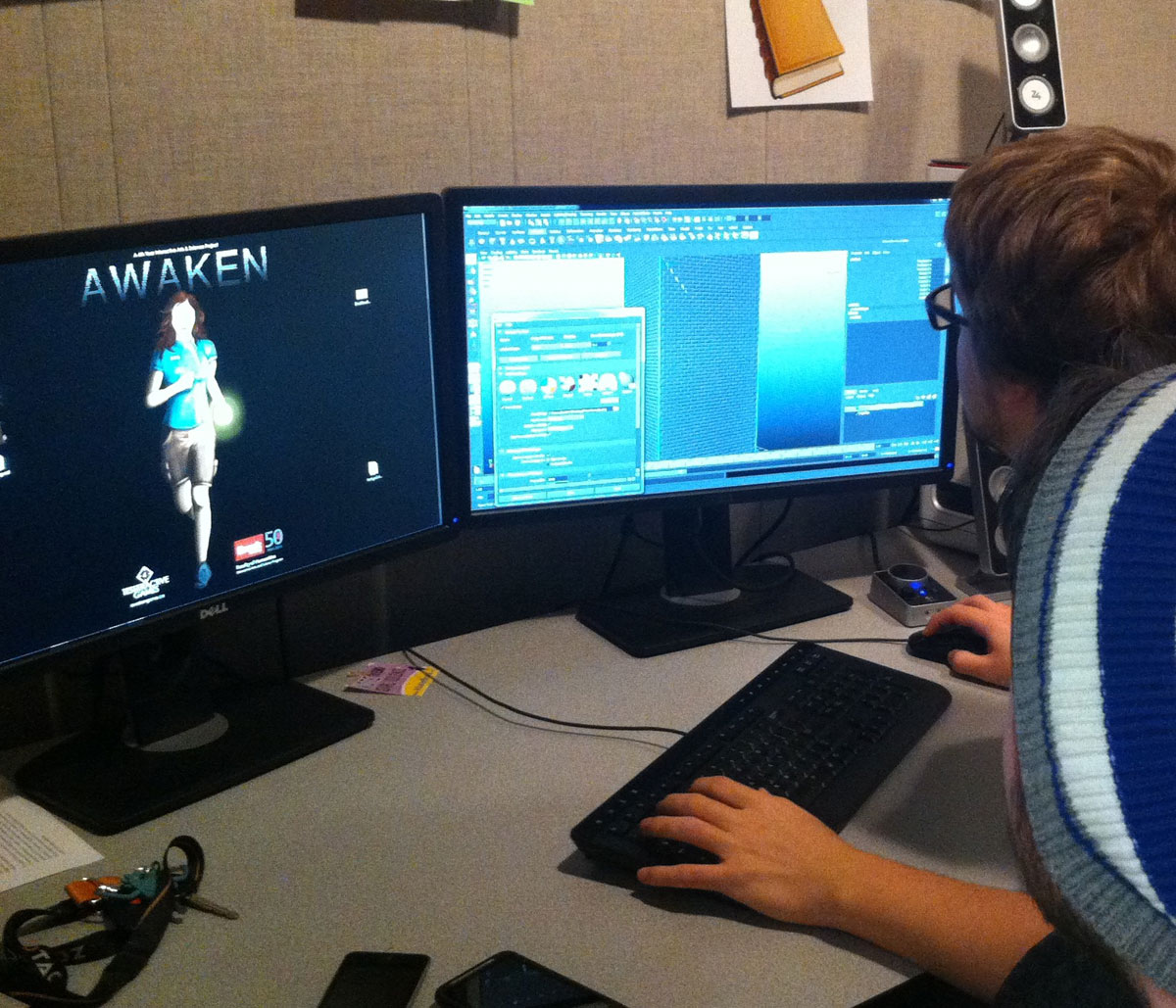Interactive Arts and Science (IASC) Program at Brock University
An interdisciplinary, degree-granting program that gives students opportunities to learn and apply skills in digital media, interactivity, and games. For more information, contact Kevin Kee or visit the website.
Mission
To combine theory and practice so that students can study how and why new media are emerging, as well as create their own integrative digital media projects.
Launched in 2006, the Interactive Arts and Science Program provides undergraduates with the opportunity to pursue interdisciplinary courses of study in areas that combine digital media and interactivity, including digital and social media, 3D online environments, computer games, and emerging digital platforms. The program aims not only to teach strong theoretical and critical content to interested students, but also to create an environment that fosters creativity, hands-on application, and public engagement.
The program is unique in its emphasis on visual aspects of interactivity and digital humanities; its growing focus on game studies; and its partnerships with local companies, many of which host student interns. IASC was the first program of its kind, and it has produced engaged and productive graduates that go on to further study or exciting employment in a range of careers.
IASC is a part of the Centre for Digital Humanities, which was founded in 2002 as university interest in humanities computing grew stronger. In addition to its support of IASC, the Centre for Digital Humanities offers teaching, research, and consultation on matters related to computation and interactivity in the humanities. The Centre also supports educational technology systems across the Faculty of Humanities, and offers a number of lab spaces for multimedia teaching, development, and game building.
People
Under the direction of Kevin Kee, the program includes a number of core faculty members and cohorts of approximately 25 undergraduates pursuing majors or minors.
IASC is open to all interested undergraduates that are admitted to the Faculty of Humanities. Each year typically sees a cohort of approximately 25 students pursuing majors or minors, for a total of 80-100 students involved in IASC at any given time. Because of the interdisciplinary nature of the program, students pursue courses of study that they tailor to their own goals and interests, which contributes to the vibrancy and diversity of each cohort. IASC makes a point to follow student outcomes after graduation, noting the types of employment or study that their graduates pursue. Alumni are invited back to speak at a number of the program’s events in order to give current students a fuller picture of what to expect as they progress and transition.
Kevin Kee
Structure
Students take a few core courses, and then craft their own cross-disciplinary path based on their interests. Many students also participate in internships at companies based at nGen, an area business incubator that partners with IASC.
Students pursuing majors or minors through the IASC program take a few required core courses that include an introductory course, courses on game play and immersive worlds, and a final team-based practicum in which they synthesize their interdisciplinary work into a final interactive, multimedia project.
Beyond the core courses, students craft their own course of interdisciplinary study based on their interests and goals. Courses are cross-listed with a variety of departments, including visual arts, drama, English, and more, which allows students to bring the methods and approaches that they learn in the core courses to a number of traditional humanities environments.
The program is further enriched by a close relationship with nGen, the Niagara Interactive Media Generator, a business incubator in the community. Students do internships with companies based at nGen to get practical experience, and leaders of nGen-based companies teach within the IASC program in courses such as 3D modeling and animation, visual effects, and live-action filming. The partnership has contributed both to the students’ success and to the vitality of the area, helping the community to evolve from a manufacturing hub to a high-tech innovator.

IASC students shoot scene on RED camera for 3rd year short film project.
Research
Alongside their studies, many students participate in public projects, such as the Niagara 1812 historical project, which allows them to apply the skills they learn to projects with immediate public relevance.
One of the required components of the IASC program is a team-based practicum in which groups of students work together to build interactive, multimedia projects that incorporate what they have learned in the preceding years. Some student work is showcased on IASC’s Facebook page (no log-in required). Their research takes the shape of games, films, 3D animation, multimedia historical interventions, and more.
Beyond the classroom, IASC’s ongoing partnership with nGen means that students have the opportunity to work with professionals to build public projects. Some of those projects can be explored on nGen’s site, as well as in The Generator at One’s portfolio.

IASC students fine-tuning their video game for 4th year class project.
Support
As an academic program within Brock’s system, IASC has a hard budget line and is not supported by grants. At the same time, some of the program’s research activities are funded through a separate research allocation.
The program is an integral part of Brock University’s academic offerings, and as such, it is supported by university funding. The research elements of the program receive separate allocations determined by the needs and scope of various projects. IASC typically does not pursue grant funding for its projects.
Faculty members frequently hold joint appointments with IASC and a home department.
Directions
The program may undergo a number of structural changes in the coming years, including launching a new stream specifically for game studies, in order to serve student needs as the program continues to evolve.
Because the program has grown and evolved since its inception in 2006, a number of structural changes may be carried out in order to continue serving the students’ needs in the best way. For instance, the increasing popularity of the game studies stream means that it will soon be structured as an independent program, with theoretical coursework taught at Brock and applied skills taught at nearby Niagara College, which specializes in that type of instruction.
While IASC is stable and well established, it began with principles of risk and experimentation, and as a result will continue evolving in new and innovative ways.
Nuts & Bolts
Though it can be challenging, creating relationships across the university and the broader community opens up valuable opportunities and amplifies the strengths of each partner.
If you are considering implementing a program similar to IASC, there are a few key factors to keep in mind:
- Consider the kinds of partnerships that might be possible, both across the institution and within the broader community. While it can be complicated and time consuming to balance the various needs and goals of multiple groups, the benefits of doing so far outweigh the challenges.
- Strong connections with public organizations and companies provide invaluable crossover opportunities, and help students to have an immediate understanding of ways that they could apply their skills beyond the walls of the university.
- IASC has thrived in part because of an institutional willingness to take risks and to correct course as necessary. Just as students are learning by building, so the program can become stronger through the course of building up new possibilities and refining them as needed.